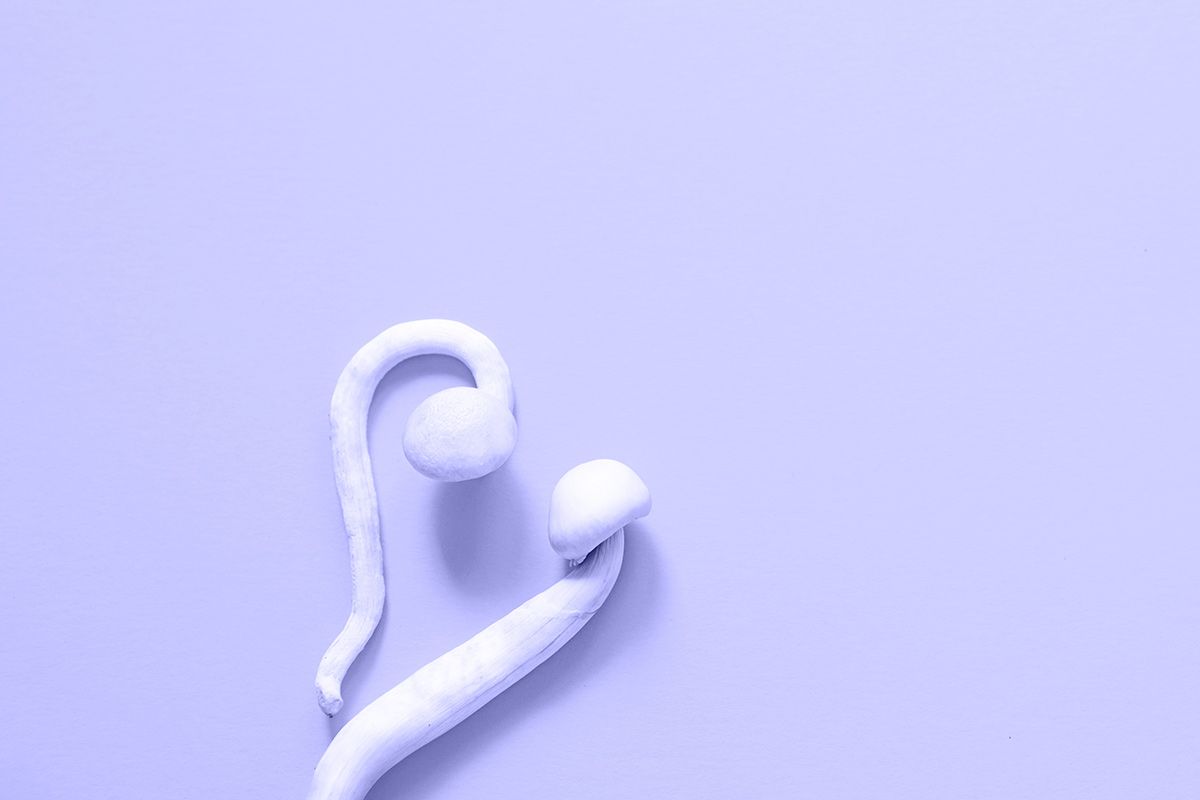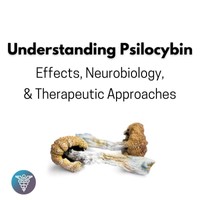Western medicine has learned so much lately about how psilocybin can help people heal. From treatment-resistant depression to anxiety, psilocybin is showing amazing positive effects for people. But where does psilocybin come from? Let’s dive into psilocybin’s biological and historical origins.
Let’s start from the ground up: psilocybin comes from fungi, or ‘magic mushrooms’. But there isn’t one psilocybin mushroom. Over 180 mushrooms create the chemical compounds psilocybin and psilocin. These mushrooms mainly come from the genus Psilocybe, but there are other genera that make them [1].
Once in the body, psilocybin quickly becomes psilocin. This is the chemical form that causes ‘tripping’. At lower doses, it can cause more subtle effects.
Why do these mushrooms make psilocybin and psilocin?
The answer may surprise you. We think that these mushrooms evolved to create psilocybin and psilocin to protect themselves from insects. These chemicals are probably evolutionary mechanisms that mushrooms use to avoid being eaten [2]. They may also have psychoactive effects on insects. It seems only by chance that they cause interesting effects on the human brain.
Other psychoactive chemicals are believed to come from this same process: they’re evolved to keep the producing species alive. The caffeine in your morning cup of coffee is a byproduct of protective evolution, and it’s a natural insecticide [3]. The coca plant produces a substance to deter insects from eating it’s leaves: cocaine [4].
Follow your Curiosity
Sign up to receive our free psychedelic courses, 45 page eBook, and special offers delivered to your inbox.The effects of psilocybin and psilocin are similar to LSD and mescaline. Mescaline comes from consuming certain types of cacti in Mexico and other areas of the United States [5]. LSD, or Lysergic Acid Diethylamide, has more similar origins to psilocybin. It’s an engineered chemical derived in a fungus that grows on rye grain [6].
Psilocybin and LSD fall under the tryptamine category of psychedelics [7]. They both change serotonin action in the brain for several hours. This produces an experience that can include sensory changes, a feeling of expansiveness, hallucinations, and even an ‘ego death’.
How is psilocybin made?
Mushrooms make psilocybin and psilocin by using four different enzymes. These have even been isolated down to their genetic components. We know now that the gene for psilocybin crosses three different genuses. We believe this “horizontal gene” has transferred between different mushroom lineages as a protective adaptation [2].
Isolating the enzymes that make psilocybin has given us the ability to create it in a lab. By using the enzymes that make psilocybin in mushrooms, scientists have made a synthetic psilocybin which can be used in drug trials and research.
Where can I find psilocybin?
The mushrooms that make psilocybin grow in south, central, and parts of north america. They tend to have long stems and small tops. But mushroom species can look a lot alike. While psilocybin mushrooms will have psychedelic effects, other mushrooms are very poisonous. We don’t advise looking for psychedelic mushrooms yourself unless you are an experienced and confident forager.
The good news is that psilocybin is getting easier to access safely. New legislation in Oregon will make it possible for anyone over 21 to access psilocybin within the next few years. A special access policy in Canada will allow doctors to request psychedelics on behalf of their patients.
With patience and time, we hope other states and countries will recognize the significant evidence on psilocybin therapy and how it can address unmet needs in mental health.
How long has psilocybin been around?
Western medicine is only recently acknowledging the legitimacy of psychedelic medicine. When we think about psilocybin now, it’s easy to contextualize it within our narrow understanding of medical research and treatment.
Many scientists believe that psilocybin has been a part of our human experiences for quite some time. Evidence shows that humans have been using psychedelics throughout our evolution [7].
In the Pliocene era (between two and five million years ago), we intensified our efforts to find sustenance from the forest floor [8]. This led us to eating more ground-level plants, like mushrooms. Imagine the surprise for the first human when they stumbled upon psilocybin in their afternoon snack!
Some scientists even believe that our evolution has been directly linked to our relationship with psychedelics [7]. Everything from our communication to creative abilities have been implicated. It’s possible that we wouldn’t be where we are today without them.
Psilocybin helps to stimulate our coping strategies. It improves our ability to solve complex problems and adapt to change, both of which are necessary skills for life on earth. Our problem-solving capabilities and flexible thinking could be credited to psilocybin’s ability to change the way we see the world [7].
Psilocybin also has effects on the dynamics within groups. Our communities and systems have allowed us to innovate and develop new ideas more than any other species. Psilocybin’s influence on suggestibility, cooperative communication, sociality, and imagination are all assets to group functioning. Psilocybin could have been an early asset to humans, helping us develop deeper connections and grow as a species [7].
Psilocybin’s cultural roots
Over time, western cultures have marginalized and stigmatized the use of psychedelics.
Mind-altering substances like psilocybin and LSD were outlawed by the US federal government in the 60’s in an effort to marginalize hippie communities. The government feared it’s “deviant potential”, and the ensuing moral panic over psychedelics curbed their influence on western culture [9].
But many indigenous cultures and groups never forgot about the importance of psilocybin. Yet as western medicine has grown it’s understanding of psychedelics, these groups have not been brought to the table. When patents come, indigenous cultures don’t receive recognition.
This pattern of colonization and appropriation is not new in western medicine. ‘Scientific expansion’ and ‘research’ have long been used as excuses to pull elements from indigenous cultures while neglecting the people within them.
Modern western culture found psilocybin within a story of cultural desecration. In 1955, a VP for J.P. Morgan lied to a Huautla medicine woman to get access to a psilocybin ceremony. This was a tradition that had been held only for tribe members.
After returning home, he wrote an article in Life magazine about the transformative experience. Soon, Huautla was flooded with psychedelic tourists from John Lennon to Mick Jagger. The village was destroyed, and the medicine woman was jailed. Her house was burned down, her son was killed, and she died in poverty.
As we move toward the future of access expansion, we need to take intentional steps to avoid these patterns of colonization. Including these groups not only gives them a voice but can strengthen our psychedelic understanding as a whole. Reciprocity and inclusion must be at the forefront. How exactly to do this is an ongoing discussion by many in the psychedelic community.
A fresh framework is necessary. New solutions, like a decentralized blockchain, could help us create more rigorous ethics within psychedelic medicine. Incorporating ancient medicine with new business models can make life better for us all only if indigenous wisdom is honored. Indigenous cultures deserve to benefit from the wisdom they’ve generously shared.
Where psilocybin comes from, and where it’s going
Psilocybin has a rich history. Its story seems to have been entwined with ours for millennia. We continue to grapple with its complex history and our own faulty assumptions. By leading with curiosity and accountability, we can create a better psychedelic experience that doesn’t neglect psilocybin’s indigenous origins.
The future of psilocybin is rich too. Psychedelic therapy isn’t just a new wave of pharmaceuticals: it’s a new framework for mental health treatment entirely. It’s a treatment based on experiences, not medications. By expanding our repertoire of mental health treatments, the hope is that we can heal humanity as individuals and a whole.
As our understanding grows, some states and countries are already taking action to expand access to psychedelic therapy. Oregon and Canada both recently made access expansions that will make it possible for people to experience psychedelics legally. We’re looking forward to similar actions in the US and abroad.
The future is bright for psilocybin. You can be part of this future by participating in psychedelic trials, becoming part of our community, or learning more about psychedelic medicine through our free resources page.
Learn everything you need to know about psilocybin in our course Understanding Psilocybin: Effects, Neurobiology & Therapeutic Approaches:
This course provides a comprehensive summary of the pharmacology and effects of psilocybin, how it works in the brain, and why people can have mystical experiences and sensory-perceptual shifts.
References
- Encyclopædia Britannica, inc. (n.d.). Psilocin and psilocybin. Encyclopædia Britannica. Retrieved February 9, 2022, from https://www.britannica.com/science/psilocin
- Reynolds, H.T., Vijayakumar, V., Gluck-Thaler, E., Korotkin, H.B., Matheny, P.B. and Slot, J.C. (2018), Horizontal gene cluster transfer increased hallucinogenic mushroom diversity. Evolution Letters, 2: 88-101. https://doi.org/10.1002/evl3.42
- Nathanson, J. A. (1984). Caffeine and related methylxanthines: Possible naturally occurring pesticides. Science, 226(4671), 184–187. https://doi.org/10.1126/science.6207592
- Nathanson, J. A., Hunnicutt, E. J., Kantham, L., & Scavone, C. (1993). Cocaine as a naturally occurring insecticide. Proceedings of the National Academy of Sciences of the United States of America, 90(20), 9645–9648. https://doi.org/10.1073/pnas.90.20.9645
- Mescaline. Mescaline – an overview | ScienceDirect Topics. (n.d.). Retrieved February 9, 2022, from https://www.sciencedirect.com/topics/neuroscience/mescaline
- Encyclopædia Britannica, inc. (n.d.). LSD. Encyclopædia Britannica. Retrieved February 9, 2022, from https://www.britannica.com/science/LSD
- Hallucinogenic mushrooms drug profile. (2013, May 1). Retrieved February 9, 2022, from https://www.emcdda.europa.eu/publications/drug-profiles/hallucinogenic-mushrooms_en
- Rodríguez Arce, J. M., & Winkelman, M. J. (2021). Psychedelics, sociality, and human evolution. Frontiers in Psychology, 12. https://doi.org/10.3389/fpsyg.2021.729425
- Goode, E. (2008). Moral panics and disproportionality: The case of LSD use in the sixties. Deviant Behavior, 29(6), 533–543. https://doi.org/10.1080/01639620701839377







